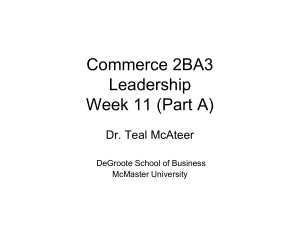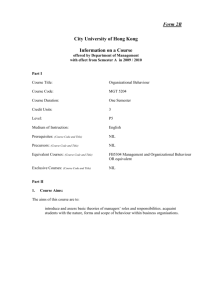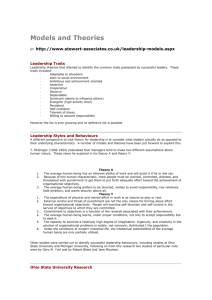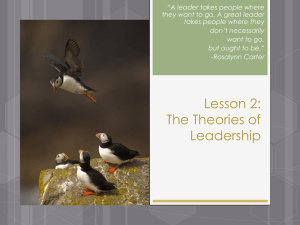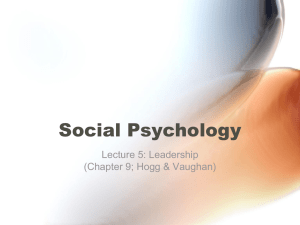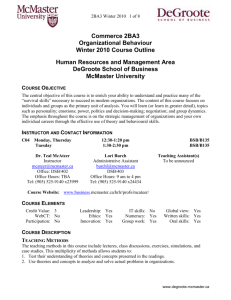Evolution of OB
advertisement
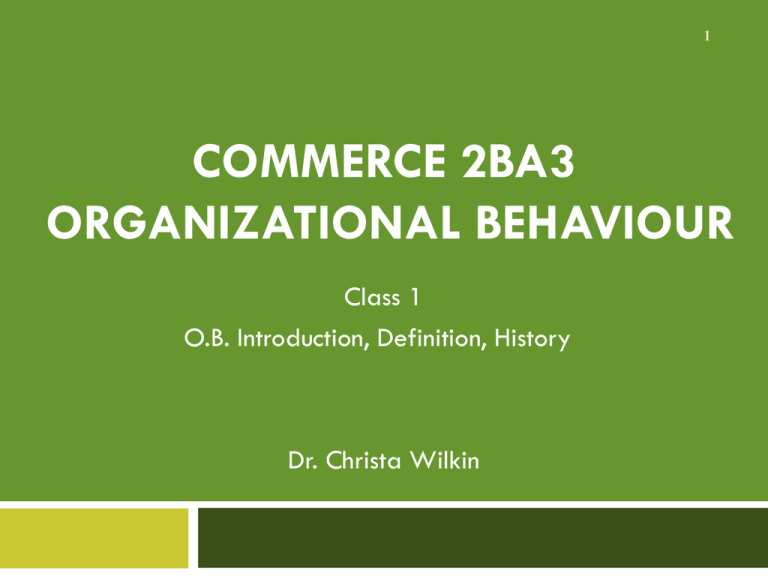
1 COMMERCE 2BA3 ORGANIZATIONAL BEHAVIOUR Class 1 O.B. Introduction, Definition, History Dr. Christa Wilkin Agenda 2 Introductions Icebreaker Course overview Introduction to OB Contemporary management concerns Introductions 3 About your instructor PhD from Mac CHRP (certified human resources professional) Experience in HR; taught 2BA3 last spring Icebreaker 4 What do we have in common? Break into groups of four to five people Find two things in common with each other E.g., food likes, sports, music, TV shows, hobbies Rule: The thing in common can’t be that you are a Mac student taking 2BA3 Pick a spokesperson who will introduce the group members and tell the class what they have in common Course Overview 5 Text available at the McMaster Bookstore: Organizational Behaviour: Understanding and Managing Life at Work (8th Edition), by Gary Johns and Alan Saks (Prentice Hall) New: ~ $130.75 Used: ~ $98.10 Format: Combination of lectures and in-class exercises How to find me… 6 Contact info: Email: AustinCL@mcmaster.ca Website: http://www.business.mcmaster.ca/courses/com2BA3/austincl/ Office phone: 525-9140 x 26167 Office hours: By appointment How to Find Your TA... 7 Chun-Hsiao (Darren) Wang E-mail: wangc28@mcmaster.ca Office phone: 905-525-9140 ext. 26359 Grading 8 Group Assignment (25%) due week 6 Random assignment to group of 3 to 4 Watch movie and apply three OB theories Mid-term (35%) in week 4 Multiple-choice Final exam (35%) in week 7 Same questions format as mid-term Participation (5%) Demonstrate engagement with the course material Course Topics 9 Ch 1: O.B. Introduction, Definition, History Ch 2: Personality & Learning Ch 3: Perception, Attribution, Judgment Ch 4: Values, Attitudes & Work Behaviour Ch 5: Theories of Work Motivation Ch 6: Motivation in Practice Ch 7: Groups and Teamwork Ch 8: Influence, Socialization, Culture Ch 9: Leadership Ch 10: Communication Ch 11: Decision Making Ch 12: Power, Politics and Ethics Ch 13: Conflict & Stress Ch 14: Organizational Structure Ch 15: Environment, Strategy, Technology Ch 16: Change, Development, Innovation MID-TERM FINAL EXAM Expectations 10 What I expect of you Attendance. I expect you to attend every class. Participation. Strongly encouraged Group work. Formed during the second week of classes What to expect from me Lecture notes will be posted by Saturday of each week Exams will be based on text and lecture notes; so even if we don’t review it in the lecture, if it is in the text, it is fair game Available after class or by appt. Use practical examples to highlight relevance of theories 11 QUESTIONS? 12 CH 1: INTRODUCTION TO OB Organizational Behavior (OB) 13 The attitudes and behaviours of individuals and groups in organizations Why study OB? Effective and competitive organizations Help you to retain the people who came up with the good ideas Useful in any job, organization, industry, anywhere Organizational Behavior (OB) 14 OB theories have widespread applications Knowing these theories can help you to: Evaluate “solutions” proposed by consultants and managers Solve new problems and adapt to new situations Stay “current” in your field Evidence-based management is crucial Evolution of OB 15 Classical View (Early 1900s) Attempts to prescribe the “correct” way to manage an organization and achieve its goals High specialization of labour (each dept tended to its own business, and decision making was centralized) Bureaucracy Max Weber Strict chain of command, detailed rules, high specialization, centralized power, and selection and promotion based on technical competence Scientific Management Frederick Taylor Use of careful research to determine degree of specialization Evolution of OB 16 Human Relations Movement Hawthorne Studies – research conducted at the Hawthorne plant of Western Electric in the 1920s that examined how psychological and social processes affect productivity How physical environment affects productivity Effect of interest being shown in them Advocates management styles that are more participative and oriented towards employee needs Question 17 Which approach (classical or human relations) is better? Which approach would you use? Evolution of OB 18 Where are we today??? The Contingency Approach No one best way to manage Management style depends on the demands of the situation What do Managers do? 19 Mintzberg Informational Roles: Ways the manager receives and transmits information (e.g., attend workshop) Interpersonal Roles: Establishing and maintaining interpersonal relations (e.g., mentor, discipline) Decisional Roles: Deal with decision making (e.g,. conflicts) Quiz Question 20 The contingency approach to management suggests that: A) Management style depends on the demands of the situation. B) The best management style depends on the size of the organization. C) Management style makes no difference. D) Management styles are constantly changing. E) One management style should work for all individuals. 21 CONTEMPORARY MANAGEMENT CONCERNS Focus on Quality, Speed, and Flexibility 22 Intense competition has given rise to the need for organizations to improve quality, speed, and flexibility. This requires a high degree of employee involvement, commitment, and teamwork. Organizational behaviour is concerned with these issues. Recruitment and Retention 23 A major challenge facing organizations today is the recruitment and retention of skilled employees. Canadian organizations face severe shortages of labour in the coming years and many are already having trouble hiring and retaining employees. Question: Why do you think this is the case? Organizational behaviour can help companies improve their recruitment and retention and become an employer of choice. Workplace Diversity 24 More women in workforce and professions Different needs of Gen-X/Gen-Y and babyboomers Diversity has advantages, but firms need to adjust Employee-Employer Relationships 25 Employability “New deal” relationship Continuously learn new skills Contingent work No contract for LT employment Minimum hours of work vary Consequences Decreased trust, lower morale, decline in job satisfaction, increased stress, absenteeism on the rise 26 QUESTIONS? Summary 27 OB has widespread applications Evolution of OB Classical Human Relations Managers have different roles Contingency Receive and transmit information Interact with people Make decisions Contemporary Concerns Quality, speed, flexibility Recruitment and Retention Workplace diversity Employment relationship For Next Class 28 Read chapters two and three *** Remember your namecard ***
